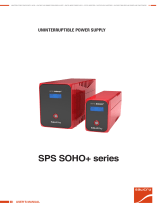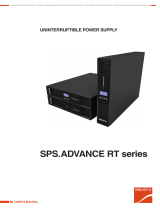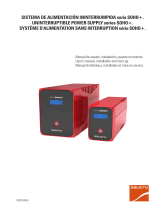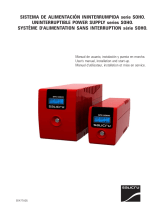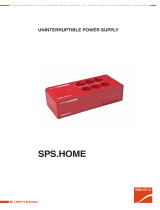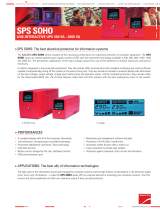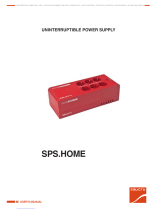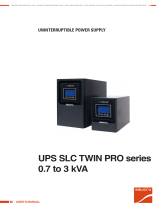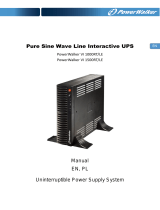Page is loading ...

SPS.ONE
UNINTERRUPTIBLE POWER SUPPLY (UPS) SYSTEMS
USER MANUAL

2SALICRU

3
General index
1. INTRODUCTION
1.1. THANK-YOU LETTER
2. SAFETY INFORMATION
2.1. USING THIS MANUAL
2.1.1. Conventions and symbols
3. QUALITY ASSURANCE
AND STANDARDS
3.1. MANAGEMENT STATEMENT
3.2. STANDARDS
3.3. ENVIRONMENT
4. PRESENTATION
4.1. DIAGRAMS
4.1.1. Unit diagrams
4.1.2. Unit diagram key
4.2. CONTENTS
4.3. OPERATING PRINCIPLE
4.3.1. Features
5. INSTALLATION
5.1. STORAGE LOCATION AND CONDITIONS
5.2. CONNECTING THE UNIT TO THE MAINS FOR THE FIRST
TIME OR AFTER IT HAS BEEN OUT OF USE FOR TWO
MONTHS
5.3. CONNECTING THE LOADS
5.4. CONNECTING THE COMMUNICATION CABLE
5.5. DOWNLOADING AND INSTALLING THE SOFTWARE
5.6. STARTING UP/STOPPING THE UNIT
5.6.1. Starting up the SPS.ONE
5.6.2. Stopping the SPS.ONE
6. TROUBLESHOOTING GUIDE
7. GENERAL TECHNICAL
SPECIFICATIONS
USER MANUAL SPS.ONE UNINTERRUPTIBLE POWER SUPPLY (UPS) SYSTEMS

4SALICRU
SALICRU
1. INTRODUCTION
1.1. THANK-YOU LETTER
We would like to thank you for purchasing this product. Read
this instruction manual carefully in order to familiarise yourself
with its contents. You will get the most out of the unit, achieve
a higher the degree of satisfaction and guarantee high levels of
safety the more you understand the unit.
Please do not hesitate to contact us for any further information
or any questions you may have.
Yours sincerely,
•The unit described in this manual can cause serious
physical injury if handled incorrectly. Therefore, the
unit must only be installed, serviced and/or repaired by our
staff or by qualified personnel.
•Although every effort has been made to guarantee that the
information in this user manual is complete and accurate,
we are not responsible for any errors or omissions that may
be present.
The images included in this document are for illustrative
purposes only and may not accurately represent the parts
of the unit shown in this manual. However, any differences
will be reduced or resolved through the correct labelling on
the unit.
•In line with our policy of continuous development, we
reserve the right to modify the specifications, oper-
ating principle or actions described in this document
without prior notice.
•The reproduction, copying, transfer to third parties,
modification or translation in full or in part of this
manual or document, in any form or by any means, without
prior written consent from our company, is prohibited,
with us reserving the full and exclusive right of ownership
to it.

5
2. SAFETY INFORMATION
2.1. USING THIS MANUAL
The user manual is available for customers on our website. It
can be read online or downloaded, as appropriate.
In addition to reading the manual, it is necessary to access
document EK266*08, relating to the "Safety instructions".
Please read these instructions carefully before carrying out any
action on the unit in terms of installation or start-up, change of
location, configuration or handling of any type.
The purpose of the user manual is to provide information re-
lating to safety, as well as explanations about the unit's in-
stallation and operating procedures. Read them carefully and
follow the steps in the corresponding order.
Compliance as regards the "Safety instructions"
is mandatory, with the user being legally respon-
sible for observing and applying them.
All units are supplied with the corresponding labels to guar-
antee the correct identification of each part. In addition, the
user can refer to the user manual at any time during installation
or start-up operation, which provides clear, well-organised and
easy-to-understand information.
Finally, once the unit is installed and in operation, we recom-
mend that you keep the documentation in a safe place that is
easy to access, in case of any future queries that may arise.
The following terms are used interchangeably in the document
to refer to:
•"SPS.ONE, equipment, system, unit or UPS".- SPS.ONE
Uninterruptible Power Supply System.
Depending on the context of the sentence, they may refer
interchangeably to the UPS itself or to the UPS and the bat-
teries.
•"Batteries or capacitor banks".- A group or set of ele-
ments that stores the flow of electrons by electrochemical
means.
•"S.T.S.".- Service and Technical Support.
•"customer, installer, operator or user".- They are used
interchangeably and, by extension, to refer to the installer
and/or the operator who will carry out the corresponding
actions, whereby the responsibility for carrying out the
respective actions may be held by the same person when
they act on behalf or in representation of the installer or
operator.
2.1.1. Conventions and symbols
Some symbols may be used and may appear on the unit, bat-
teries and/or in the user manual.
For more information, see section 1.1.1 of document EK266*08
relating to the "Safety Instructions".
USER MANUAL SPS.ONE UNINTERRUPTIBLE POWER SUPPLY (UPS) SYSTEMS

6SALICRU
3. QUALITY ASSURANCE
AND STANDARDS
3.1. MANAGEMENT STATEMENT
Our aim is to satisfy our customers. Management has estab-
lished a Quality and Environmental Policy for such purposes. As a
result, a Quality and Environmental Management System will be
implemented, which will ensure that we are compliant with the
requirements of the ISO 9001 and ISO 14001 standards and that
we meet all customer and stakeholder requirements.
The company management is also committed to the develop-
ment and improvement of the Quality and Environmental Man-
agement System, through:
•Communication to the entire company of the importance of
satisfaction, both in terms of the customer’s requirements,
as well as legal and regulatory requirements.
•Dissemination of the Quality and Environmental Policy and
setting of the Quality and Environment targets.
•Management reviews.
•Provision of the necessary resources.
3.2. STANDARDS
The SPS.ONE product is designed, manufactured and mar-
keted in accordance with the EN ISO 9001 standard on Quality
Assurance and is certified by SGS. The mark indicates
conformity with the EEC Directives through application of the
following standards:
•2014/35/UE on Low Voltage Safety.
•2014/30/UE on Electromagnetic Compatibility (EMC).
According to the specifications of harmonised standards. Ref-
erence standards:
•EN-IEC 62040-1. Uninterruptible power systems (UPS).
Part 1-1: General and safety requirements for UPS
used in user access areas.
•EN-IEC 62040-2. Uninterruptible power systems (UPS).
Part 2: Electromagnetic compatibility (EMC) requirements.
The manufacturer shall not be held responsible for any
damage caused by the user after altering or tampering
with the unit in any way.
This product is suitable for use in both single-user pro-
fessional and domestic applications.
The EC declaration of conformity for the product is
available for the customer and can be requested from
our head office.
3.3. ENVIRONMENT
This product has been designed with the protection of the en-
vironment in mind and has been manufactured in accordance
with the ISO 14001 standard.
Recycling the unit at the end of its useful life:
Our company commits to using the services of approved com-
panies that comply with the regulations in order to process the
recovered product at the end of its useful life (please contact
your distributor).
Packaging:
To recycle the packaging, follow the applicable legal regula-
tions, depending on the particular standards of the country
where the unit is installed.
Batteries:
The batteries represent a serious health and environmental
risk. They must be disposed of in accordance with the appli-
cable laws.

7
4. PRESENTATION
4.1. DIAGRAMS
4.1.1. Unit diagrams
Figures 1 to 4 show illustrations of the units, according to the
model. Nevertheless and as the product is continuously being
developed, there may be slight discrepancies or inconsisten-
cies. Therefore, in the case of any queries, the labels on the unit
will always take precedence.
All of the values for the main specifications or features
can be checked on the unit's name plate. Act accord-
ingly for your installation.
SPS.500.ONE, SPS.700.ONE
and SPS.900.ONE
SPS.1100.ONE, SPS.1500.ONE
and SPS.2000.ONE
7
8
9
10
7
8
9
10
Fig. 1. Front views of SPS.ONE.
SPS.1100.ONE SPS.1500.ONE and
SPS.2000.ONE
SPS.500.ONE, SPS.700.ONE
and SPS.900.ONE
1 5 4 3 1 5 3 4 1 5 6 3 4
Fig. 2. Rear views, with Schuko sockets.
USER MANUAL SPS.ONE UNINTERRUPTIBLE POWER SUPPLY (UPS) SYSTEMS

8SALICRU
SPS.1100.ONE SPS.1500.ONE and
SPS.2000.ONE
SPS.500.ONE, SPS.700.ONE
and SPS.900.ONE
1 5 4 3 1 5 4 3 1 5 6 3 4
Fig. 3. Rear views, with British (UK) sockets.
SPS.1100.ONE SPS.1500.ONE and
SPS.2000.ONE
SPS.500.ONE, SPS.700.ONE
and SPS.900.ONE
5 2 4 3 3 4 2 5 3 6 4 2 5
Fig. 4. Rear views, with IEC sockets.

9
4.1.2. Unit diagram key
1. Power cable with pin on end.
2. IEC socket used to power the unit (only in models
without the power supply cable 1).
3. Output sockets.
4. USB HID communication port.
5. Input protection via circuit breaker or fuse, depending
on the model.
6. Fan of the unit (only in models SPS.1500.ONE and
SPS.2000.ONE).
7. Unit start and stop button.
8. Red LED on. Equipment in Failure Mode. This led is also
used to warn that the equipment is near the end of au-
tonomy (in fixed mode).
9. Flashing yellow LED. Unit in the Battery Mode - output
power supply from the internal battery-.
10. Green LED on. Unit in the AC Mode - output power supply
from the input voltage-.
4.2. CONTENTS
The following is supplied within the unit's packaging:
•For the models with UK and Schuko sockets:
–SPS.ONE unit.
–Quick guide.
–USB HID communication cable.
•For models with IEC sockets:
–SPS.ONE unit.
–Quick guide.
–USB HID communication cable.
–1 output cable for models 500/700/900 and 2
output cables for models 1100/1500/2000.
4.3. OPERATING PRINCIPLE
•It is an Uninterruptible Power Supply (UPS) system with
line-interactive technology that offers the best protec-
tion solution for the units and the information that make
up both domestic and professional IT environments (small
businesses, offices, shops, etc.).
•The use of AVR Boost&Buck technology - permanent stabi-
lisation of the supply voltage - provides a two-fold advan-
tage: higher protection of connected loads, combined with
a reduced use of UPS batteries.
•In the case of a power supply outage, it supplies electrical
power from the batteries to ensure the units continue op-
erating.
•It is also worth mentioning the built-in communication
functions to communicate between the UPS and computer
system through the USB HID port (communication cable
supplied with the unit) and the monitoring software, com-
patible with Windows, Linux, Unix and Mac.
4.3.1. Features
•Line-interactive technology
•High level of reliability through control by microprocessor
•AVR Boost&Buck permanent stabilisation
•USB HID interface in all models, by default
•Monitoring software for Windows, Linux, Unix and Mac
•A single on/off button for easy and convenient use
•Protection against overloads, short-circuits and transients
•Smart battery charger that reduces the average recharging
time
•Recharging the batteries with the equipment switched off
•Cold start function using the batteries (not connected to the
mains)
•Automatic start-up after the input voltage is reconnected
USER MANUAL SPS.ONE UNINTERRUPTIBLE POWER SUPPLY (UPS) SYSTEMS

10 SALICRU
5. INSTALLATION
•Read and follow the Safety Information set out in
chapter 2 of this document. Failure to adhere to any
of the indications set out in chapter 2 may cause a serious
or very serious accident for those who are in direct contact
with the unit or who are in the vicinity, as well as faults in
the unit and/or in the loads connected to it.
•Check that the information on the name plate is the right
information for the installation.
•Once you have unpacked the unit, inspect it and ensure that it
is in perfect condition before proceeding. If this is not the case,
please contact your distributor.
•Limitations to the connection and use of the unit ac-
cording to its morphology and sector or work envi-
ronment:
For its connection.
–In units with a power supply plug and output
sockets (with no connection terminals).
It can be connected by staff with no specific
technical training; in general, by anyone who
uses household appliances.
For its use.
–Unit with no connection terminals, generally
designed for household environments and, to a
lesser extent, for shops, industry and other sectors.
The unit can be used by staff with no specific
technical training by simply following the in-
structions in the user manual.
•Always bear in mind that the UPS is an electrical gen-
erator, which is why the user must take the necessary
precautions to prevent direct or indirect contact.
5.1. STORAGE LOCATION AND CONDITIONS
•Install the UPS in a protected area that does not have ex-
cessive humidity but has suitable ventilation.
•Place the UPS at a distance of at least 20 cm from other
units to prevent interference.
•Do not operate the unit where the temperature and hu-
midity exceed the permitted limits (see the technical speci-
fications).
20 cm 20 cm
5.2. CONNECTING THE UNIT TO THE MAINS FOR THE FIRST
TIME OR AFTER IT HAS BEEN OUT OF USE FOR
TWO MONTHS
•Insert the mains plug 1 into an AC socket.
In models with an IEC socket, a cable is
supplied to power the unit. Insert the end
of the connector into the base 2 and the
plug on the other end into the AC socket.
•For the best results, charge the battery
for at least 4 hours before using the unit
for the first time or when it has been out
of use for more than two months.
Otherwise, the SPS.ONE may not react in
a satisfactory way if there is an outage
during the initial operating hours. Its response capacity
during unexpected AC power supply failures is dependent on
the energy accumulated in the battery.
•The battery charges by simply connecting the unit to the
mains.
5.3. CONNECTING THE LOADS
•Connect the loads to the sockets 3 on the rear of the unit.
•Never connect a laser printer or
scanner to the UPS. This may
damage the unit and/or consume the en-
ergy stored in the batteries, which is re-
served for other more sensitive and more
important types of loads.

11
5.4. CONNECTING THE COMMUNICATION CABLE
•To enable unattended start-up/stop of the UPS and to mon-
itor its status, connect one end of the communication cable
to the connector 4 of the USB HID port of SPS.ONE and the
other end to the communication port of the PC.
•With the monitoring software installed in your PC, you can
programme the UPS start-up/stopping time, as well as
monitor its status in real-time. Follow the steps described
below before downloading and installing the monitoring
software:
5.5. DOWNLOADING AND INSTALLING THE SOFTWARE
•To download the free monitoring software, register as a
user and then register your unit(s) at the following site:
support.salicru.com
•You will find a link to the "ACTIVATION GUIDE" on the reg-
istration page. Follow the steps indicated.
•Once you have registered, you can download the software
for each model from the site:
support.salicru.com/software
•Use with your installation as with any other type of soft-
ware.
•When you reboot your PC, the monitoring software will ap-
pear as an orange icon on the system tray, next to the clock.
5.6. STARTING UP/STOPPING THE UNIT
5.6.1. Starting up the SPS.ONE
•With SPS.ONE stopped, press the button 7 to start the unit.
•Start up the loads.
5.6.2. Stopping the SPS.ONE
•Stopping the loads.
•Switch the unit off, press the button 7.
USER MANUAL SPS.ONE UNINTERRUPTIBLE POWER SUPPLY (UPS) SYSTEMS

12 SALICRU
6. TROUBLESHOOTING GUIDE
Use the following table to resolve minor issues:
Problem Possible cause Solutions
No LED is lit on
the front panel.
Low battery. Charge the UPS for at least 6
hours.
Battery fault. Replace the battery with the
same model.
The UPS is not ON. Press the UPS start-up button
again.
The alarm
sounds
continuously
when connected
to the mains.
The UPS is
overloaded.
First, disconnect a few loads.
Before starting it up again,
check that the connected load
matches the unit's power
specifications.
In the case of
a problem in
the mains, the
operating time
is very short.
The UPS is
overloaded. Disconnect critical loads.
Battery voltage is
too low.
Charge the UPS for at least 6
hours.
Defective battery. It
may be due to the
ambient temperature
or inappropriate
operation.
Replace the battery with the
same model.
There are no
problems in the
mains but the
unit is in battery
mode.
The mains cable plug
is not connected
correctly.
Reconnect the mains cable
plug correctly.
Tabla 1. Troubleshooting table.
•If you are registered on the website:
support.salicru.com
, you can access:
support.salicru.com/troubleshooting
, to consult the extended troubleshooting guide of the unit,
in addition to accessing other services available for regis-
tered users.

13
7. GENERAL TECHNICAL
SPECIFICATIONS
MODEL 500 700 900 1100 1500 2000
Power (VA) 500 700 900 1100 1500 2000
Power (W) 240 360 480 600 900 1200
Technology Line-interactive
INPUT
Voltage (1) 220 / 230 / 240 VAC.
Margins 162-290 VAC.
Nominal
frequency 50 / 60 Hz.
Frequency auto-
detect Yes.
Stabilisation AVR buck/boost.
OUTPUT
Voltage (VAC) 220 / 230 / 240 VAC.
Voltage accuracy (2) ± 10 %.
Frequency (2) 50 / 60 ± 1 Hz.
Waveform (2) Pseudo-sine (simulated sine).
Available socket
types Schuko (DIN), British (UK), IEC.
MODEL 500 700 900 1100 1500 2000
Transfer time standard 2-6 ms, maximum 10 ms.
PROTECTION
Input Thermal self-resetting or fuse (according to the
model).
Complete
protection
Overload, battery discharged and overcurrent in the
charging device.
BATTERY
Type Sealed Pb-Ca, maintenance free, useful life of 3-5 years.
Charge time 4 -6 hours to charge 90% of its capacity.
Can be replaced by
the user Yes.
Capacity (Ah) 4.5 7 9 7 9
Number 1 2
FUNCTIONS
Cold start Yes.
Automatic restart Yes, once the operating time has ended and after
reconnected to the mains.
OPTICAL LED INDICATIONS AND ACOUSTIC ALARMS
Normal operation,
connected to the
mains
Green LED On
Alarm Off
Mains error and
UPS in the battery
mode
Yellow LED flashing
Beeping sound every 10 sec.
Low battery Yellow LED flashing. Red LED On
Beeping sound every sec.
UPS stopped Green LED Off
Alarm Off
UPS fault Red LED On
Constant beeping
MODEL 500 700 900 1100 1500 2000
COMMUNICATION
Port USB HID
Software Supports Windows, Linux, Unix and Mac operating
systems
Download from support.salicru.com
GENERAL
Maximum altitude 2400 m a.s.l.
Relative humidity Up to 90%, non-condensing
Temperature 0.. 40ºC
Acoustic noise at
1 m. < 40 dBA
STANDARDS
Safety EN-IEC 62040-1
Electromagnetic
compatibility. (EMC) EN-IEC 62040-2
Quality and
Environmental
Management
ISO 9001 and ISO 14001
DIMENSIONS AND WEIGHT
Depth (mm.) 300 320
Width (mm.) 101 130
Height (mm.) 142 182
Net weight (kg.) 3.50 4.45 4.90 8.20 10.40 11.00
(1) The autonomy and power of the equipment can be
affected depending on the input voltage.
(2) Battery Mode.
Tabla 2. General technical specifications.
USER MANUAL SPS.ONE UNINTERRUPTIBLE POWER SUPPLY (UPS) SYSTEMS

14 SALICRU
: .............................................................................................................................................................................................................
.........................................................................................................................................................................................................................
.........................................................................................................................................................................................................................
.........................................................................................................................................................................................................................
.........................................................................................................................................................................................................................
.........................................................................................................................................................................................................................
.........................................................................................................................................................................................................................
.........................................................................................................................................................................................................................
.........................................................................................................................................................................................................................
.........................................................................................................................................................................................................................
.........................................................................................................................................................................................................................
.........................................................................................................................................................................................................................
.........................................................................................................................................................................................................................
.........................................................................................................................................................................................................................
.........................................................................................................................................................................................................................
.........................................................................................................................................................................................................................
.........................................................................................................................................................................................................................
.........................................................................................................................................................................................................................
.........................................................................................................................................................................................................................
.........................................................................................................................................................................................................................

15
: .............................................................................................................................................................................................................
.........................................................................................................................................................................................................................
.........................................................................................................................................................................................................................
.........................................................................................................................................................................................................................
.........................................................................................................................................................................................................................
.........................................................................................................................................................................................................................
.........................................................................................................................................................................................................................
.........................................................................................................................................................................................................................
.........................................................................................................................................................................................................................
.........................................................................................................................................................................................................................
.........................................................................................................................................................................................................................
.........................................................................................................................................................................................................................
.........................................................................................................................................................................................................................
.........................................................................................................................................................................................................................
.........................................................................................................................................................................................................................
.........................................................................................................................................................................................................................
.........................................................................................................................................................................................................................
.........................................................................................................................................................................................................................
.........................................................................................................................................................................................................................
.........................................................................................................................................................................................................................
USER MANUAL SPS.ONE UNINTERRUPTIBLE POWER SUPPLY (UPS) SYSTEMS

www.linkedin.com/company/salicru
@salicru_SA
Avda. de la Serra 100
08460 Palautordera
BARCELONA
Tel. +34 93 848 24 00
SALICRU.COM
Product Range
Uninterruptible Power Supplies (UPS)
Lighting Flow Dimmer-Stabilisers
DC Power Systems
Static Inverters
Photovoltaic Inverters
Voltage stabilisers
The Technical Service and Support (T.S.S.) network, Com-
mercial network and warranty information are available in
website:
www.salicru.com
REF. EK808G01 REV. G CODE 401*
/
